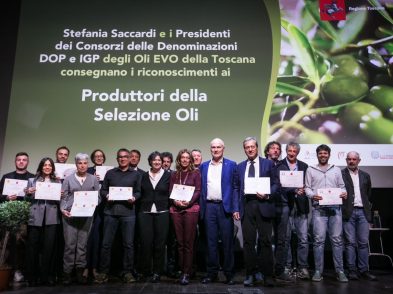It’s olive harvest season. Time stops; nets and parachutes burst open like giant mushrooms in the November green olive orchards surrounding our city. This is where one of the world’s best quality extra virgin olive oil is produced.
Fairly out of place with every day’s frantic pace, harvesting olives in the hills around Florence has little to do with time, money, traffic, or pollution. Every year, when olives start to ripen from green to black, we drift to a different era, bringing back the values of good quality life, friendship, teamwork, and peace. Olive picking is a fun, fruitful, and healthy open-air activity. Contact with nature hardly gets more intimate than swinging on an olive branch amid perfumed leaves, watching the world from a different perspective, from under showers of olives. The happy celebration reaches its climax at the stone mill, where a precious golden liqueur is extracted from the gathered fruit.
Olive oil has been more than mere condiment to the peoples of the Mediterranean; it has been medicinal and magical, as well as an endless source of fascination and wonder – the fountain of great wealth and power. The culture originated in the Caucasus, where a bushy tree was pruned to produce more of its oily fruit, a magical procedure that travelled to Syria, Palestine, Crete, and Egypt between 5000 BCE and 1400 BCE. Imported by the Greeks in southern Italy from the seventh century BCE, the Olea Europaea trees we see today share the same roots of the trees planted in Tuscany around 600 BCE by the Etruscans, who adopted the symbol of abundance, glory, and peace from Greece. In subsequent centuries, the Romans increased their wealth by spreading the source of profitable oil trades across the peninsula and since then, their number has only been increasing. There are currently over 500 kinds of olive trees in Italy, and their cultivation has fascinated many regions of the world.
Each type of tree has its own style. When lacking seasonal care and attention, a tree tends to go back to its wild and scruffy nature. Pruning takes place between the last cold winter wave and spring’s wake up call, between February and March. There are 15 or more criteria to follow contemporaneously before cutting off each branch, leaving half the tree pruned. Besides the basic rules to follow, one of which depends on how much rainfall will bless the summer, gentlemen farmers add their own touch to enjoy the ornamental value of these wonderful silvery trees.
Best quality oils are harvested ex albis ulivis, that is from the olive tree when olives are still green. Forcing the olives to fall on nets carefully laid out, twenty to thirty kilos of olives for an average size tree are gathered into boxes, and are either laid out for no more than a few days or brought immediately for milling in batches of up to 300 kilos. The amount of time between harvest and milling will influence taste and rate (the percentage of oil [in kilos] extracted from 100 kilos of olives). In Tuscany these rules are rigorously followed to preserve organoleptic properties and culinary virtues of the olio nuovo, the new oil. Organoleptic rating is based on taste – sweet to spicy, fragrance – delicate to strong, and colour – ranging from golden yellow to opaque green.
The oil, comprising 11 to 25 percent of the olive, is extracted by crushing and mixing the olives in a mill with two granite millstones that roll within a metal basin. The method is very simple. Originally, the paste resulting from crushing the olives was left for several hours for clarification, the process in which the heavier solid particles separate from water and from the lighter oil floating on the surface. Today, centrifuges accelerate the process, carefully maintaining the critical-for-quality temperature below 28 degrees Celsius.
Flowing out of impeccably clean inox equipment, a mystical glowing green juice illuminates the mill. The colour is preserved by avoiding oxidation with air particles, a reaction enhanced by heat or light, which is why olive oil is bottled and preserved in dark glass, despite its flashy look when presented in transparent amphorae. Celebrations start. A fireplace warms the atmosphere on chilly nights at local mills. When aromas of fresh olive juice stimulate the appetite, the waiting room turns into a banquet; sausages are fast on the grill next to bruschetta, to savour the olio nuovo. Wine is guest to this event, and the olive oil is equally precious, although less commercially profitable; while the wine improves with time, the oil is best when fresh and spicy.
Happily, olive oil is healthy. It aids digestion; thins the blood (which helps combat heart disease); builds bone mass; helps to assimilate vitamins A, D, and K; slows down the aging process; and helps with bile, liver, and intestinal functions.
Enjoy Olio Nuovo!
With the expert guidance of maestri oleari (master oliviers), Olio dal Vivo at Villa Medicea di Lilliano on Saturday 26th and Sunday 27th of November is an upcoming olive oil event. Amidst Jazz music, live olive oil production, and tasting lessons, Italy’s major olive oil producers are promoting this year’s olio nuovo. Entry fee is £ 7, reduced £5, and free for children under twelve. On the same weekend, at “Olio Nuovo e Gusti d’Autunno” culinary artisans will host a public olive oil tasting and will be selling traditional seasonal groceries in Impruneta’s Piazza Buondelmonti.






